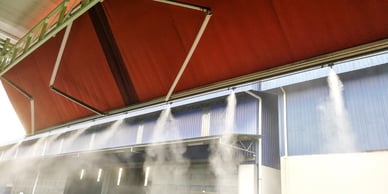Find the basic outline of a misting system, common issues, and best practices for the system.
 Shown above is a general misting system. In the diagram you can see the pump pulls water from a supply tank through a filter and sends the water one of two ways. One outlet leads to a series of nozzles while the other regulates and monitors pressure. The latter outlet mentioned ends up being by-passed back to the inlet. Here are a few things to take note of, avoid, and help to make your system the best it can be.
Shown above is a general misting system. In the diagram you can see the pump pulls water from a supply tank through a filter and sends the water one of two ways. One outlet leads to a series of nozzles while the other regulates and monitors pressure. The latter outlet mentioned ends up being by-passed back to the inlet. Here are a few things to take note of, avoid, and help to make your system the best it can be.
Firstly, choose the right pump. To reach the desired pressures and flows your system needs, please visit this page to view Pumptec's pump options. Each misting system varies and has specific needs. Second, the pump needs enough water. Do not run the pump dry - make sure your hoses are properly sized and all connection points are water tight. We typically recommend using 1/2" S-hose to feed pump inlets, Pumptec pulse hose for pressurized outlets/sections of the system, and 3/8" to 1/2" S-hose on by-pass lines. These hoses keep great shape and allow enough flow. Starving the pump will lead to cavitation. These hoses easily connect with the needed strainers and filters between tank and pump. In some instances, it would be appropriate to pressure-feed the system using city water sources.
Once the fluid leaves the pump, it is imperative to use a dampening hose. At Pumptec, 3/8" pulse hose is widely used. Because of the high operating pressure and the nature of our plunger pumps, the outlet hose type is extremely important to functionality. Be sure to always double check that your inlet and outlet hoses do not get pinched or damaged so as not to overpressure or run the pump dry. Do not run your by-pass line directly back to the pump without the use of an in-line filter. Pay attention to your gauge, so you do not over-amp your motor or over-pressurize your pump.
 It is critical to size the pump correctly in a misting application. If insufficient flow is chosen, then proper atomization and droplet size will not be possible. Excessive flow will result in unnecessary wear and wasted energy. If overheating is an issue, route the by-pass fluid back to the solution tank. This will help keep the fluid running through the pump cooler and avoid cavitation.
It is critical to size the pump correctly in a misting application. If insufficient flow is chosen, then proper atomization and droplet size will not be possible. Excessive flow will result in unnecessary wear and wasted energy. If overheating is an issue, route the by-pass fluid back to the solution tank. This will help keep the fluid running through the pump cooler and avoid cavitation.
To reiterate, avoid starving or running the pump dry, pinched lines, incorrect pressure limits or pressure spikes, overworking the motor and/or pump, and overheating your water, pump and/or motor. Avoiding negative head pressure is also preferrable - this means that the solution tank the pump is drawing from is placed above the pump. One last thing to look for is a dysfunctional nozzle - they may be damaged, worn out, or clogged.
Regarding nozzles, it is important to understand that nozzle sizes are additive. For example, 2 pieces of no. 02 nozzles equal the performance of a single 04 nozzle. Normal check ups and maintenance checks are recommended on all pumps, hoses, fittings, and nozzles. Below are a few helpful links regarding sprayers/ag units, pump maintenance, and more.
Helpful Links:
Misting Pump Demo: How PSI Affects Droplet Size
Rotary Vane Pumps vs. Plunger Pump for Mosquito Misting Systems